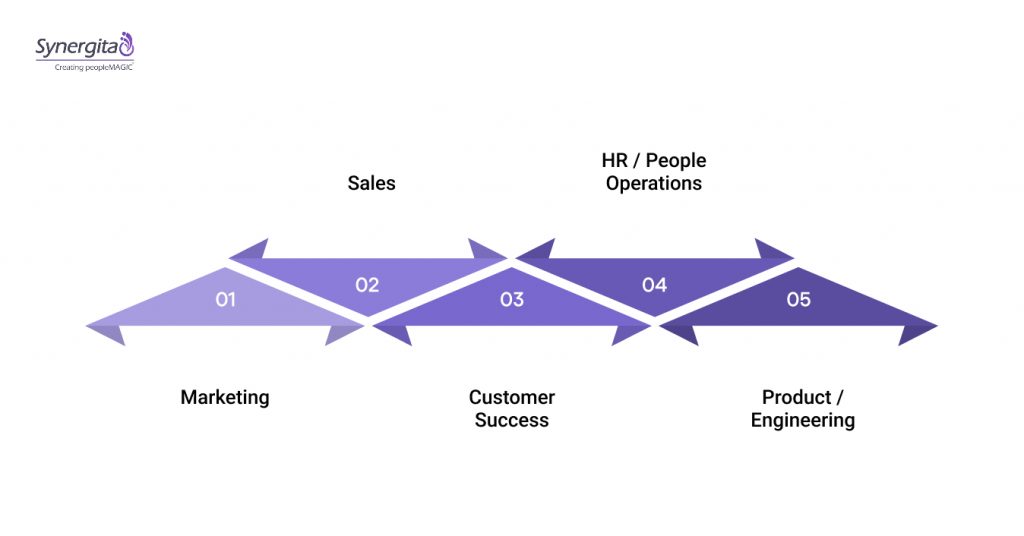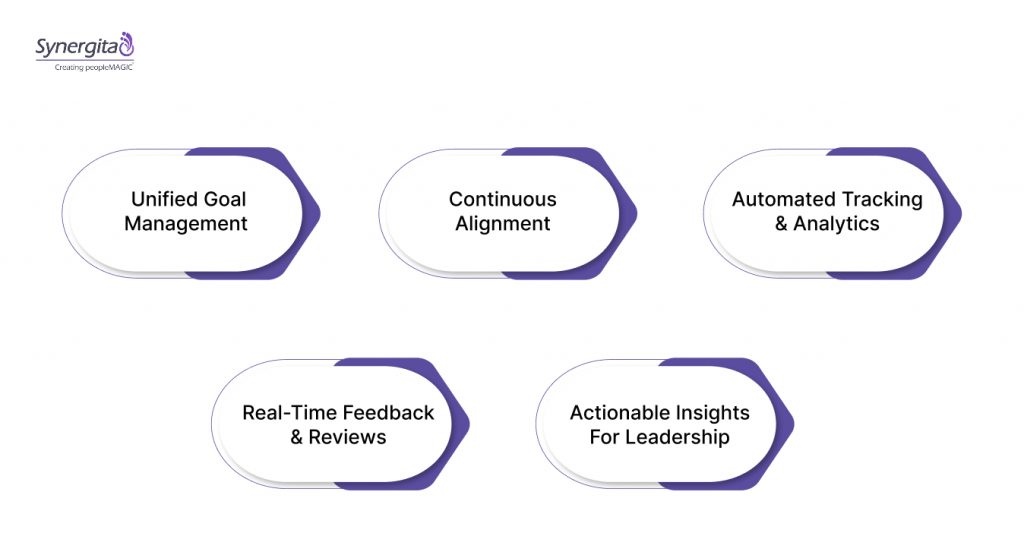According to reports, 83%of companies using the OKR framework have seen measurable benefits from its adoption. The finding highlights a growing shift toward structured goal-setting models that make performance tracking more purposeful.
As organizations review how they measure progress, the discussion around OKR vs KPI has become more relevant. Understanding how these frameworks connect helps teams choose the right approach to align goals, measure outcomes, and drive consistent improvement.
This article examines how businesses can combine both models to create a performance system that links metrics with real results.
Key Takeaways
- OKRs and KPIs serve different roles; OKRs set strategic goals, while KPIs measure ongoing performance.
- Using both frameworks together ensures balance between growth objectives and operational stability.
- Clear alignment across teams helps every metric connect to business priorities.
- Regular reviews and visibility turn performance tracking into actionable improvement.
- Integrated tools simplify the management of OKRs and KPIs, enabling measurable progress.
What Are OKRs?
OKRs focus on setting clear objectives and measurable outcomes that move a team toward strategic progress. They are used when organizations want to stretch beyond routine performance and pursue meaningful improvement.
Typical structure:
- Objective: a clear statement of what the team aims to achieve within a set period.
- Key Results: 3–5 measurable outcomes that show whether the objective is being met.
For example:
- Objective: Improve customer satisfaction across digital channels.
- Key Results: Increase NPS from 45 to 60, reduce response time to under two hours, and achieve 90% resolution on first contact.
OKRs encourage focus and accountability. They are usually reviewed quarterly, allowing teams to realign quickly if goals drift or priorities shift.
What Are KPIs?
KPIs are quantifiable measures that reflect how well a business, team or individual is performing against ongoing operational goals. They act as guardrails for performance, helping teams understand “how are we doing now?” rather than “where are we going next?”
Key characteristics include:
- They are metric-based, grounded in data (for example, monthly customer retention rate = 82 %, support tickets resolved per week = 150).
- They often track business health and stability, rather than stretch or strategic change.
- Ownership typically sits with functional teams or individuals who are accountable for maintaining performance.
When to use KPIs:
- Monitoring performance of established processes.
- Maintaining consistency and operational excellence.
- Providing dashboards, alerts and performance reviews to ensure teams stay on track.
Also Read: What are OKR Retrospectives? Key Practices and Strategies
OKR vs KPI: Understanding the Key Differences
Both OKRs and KPIs measure performance, but they serve different purposes. KPIs maintain the rhythm of daily operations, while OKRs aim to push boundaries and achieve meaningful change. Using them together gives leaders a balance between stability and growth.
| Aspect | KPI | OKR | How They Work Together |
|---|---|---|---|
| Purpose | Tracks the performance of ongoing activities | Drives improvement and strategic outcomes | KPIs highlight what’s steady; OKRs define what should improve |
| Timeframe | Continuous or annual | Typically quarterly | KPIs inform OKR goals and measure progress |
| Scope | Departmental or process-level | Cross-functional or company-wide | OKRs connect multiple KPIs to larger goals |
| Ambition | Maintains existing standards | Encourages stretch and innovation | KPIs provide baselines; OKRs raise them |
| Measurement | Output-driven (quantitative) | Outcome-driven (qualitative + quantitative) | Both are needed for a complete performance view |
| Examples | Customer churn rate, sales conversion, uptime | Launch new product with 95% user satisfaction | KPI data validates OKR success |
Used correctly, KPIs provide visibility into current performance, while OKRs help define where the next level should be.
Examples of OKRs and KPIs
Seeing both frameworks in action helps clarify how they complement each other. The difference lies in intent: KPIs tell you how you’re performing now, while OKRs define what you want to achieve next.

Marketing
- KPI: Website conversion rate = 3.2%
- OKR: Increase qualified leads by 25% through improved landing page experience
Sales
- KPI: Monthly revenue target = $1.2 million
- OKR: Expand into two new enterprise accounts this quarter and grow overall revenue by 15%
Customer Success
- KPI: Customer satisfaction score = 88%
- OKR: Raise satisfaction to 92% and reduce churn by 10% in Q2
HR / People Operations
- KPI: Employee engagement rate = 78%
- OKR: Improve engagement to 85% by introducing quarterly feedback and recognition cycles
Product / Engineering
- KPI: Average feature release cycle = 30 days
- OKR: Cut release cycle to 20 days while maintaining 95% defect-free rate
These examples show that KPIs keep teams aware of their current standing, while OKRs push them toward the next milestone.
Why Businesses Need Both OKRs and KPIs
Relying on a single framework limits progress. KPIs maintain performance, and OKRs set direction for improvement. Together, they help organizations stay consistent and move toward measurable results.
How OKRs and KPIs contribute:
- KPIs monitor ongoing performance through data on revenue, retention, and efficiency.
- OKRs define measurable outcomes that guide teams toward specific priorities.
Why balance matters:
- Overdependence on KPIs keeps attention fixed on routine targets.
- Exclusive focus on OKRs creates ambition without reliable benchmarks.
When OKRs and KPIs are aligned, every metric serves a defined purpose. Teams can see how their work contributes to broader business goals and use data to track real progress.
Common Pitfalls When Managing OKRs and KPIs
Many organizations use OKRs and KPIs without a clear structure, which weakens both frameworks. Recognizing common mistakes helps teams get better results from their performance systems.

- Treating OKRs and KPIs as the same thing: Teams often use the terms interchangeably. OKRs set directional goals, whereas KPIs measure ongoing performance. Mixing them blurs accountability and progress tracking.
- Setting too many metrics: Tracking dozens of numbers dilutes focus. Each team should identify a few meaningful OKRs and KPIs that reflect key business priorities.
- Ignoring alignment: OKRs and KPIs must connect across departments. Without alignment, teams chase local targets that do not contribute to company objectives.
- Measuring without reviewing: Metrics lose value when they are not reviewed regularly. Consistent check-ins help identify what’s working and what needs adjustment.
- Using manual or disconnected tools: Spreadsheets and isolated dashboards create visibility gaps. A unified performance system allows teams to link objectives, metrics, and progress in real time.
When organizations avoid these pitfalls, both frameworks work as intended—creating transparency, accountability, and continuous improvement.
Also Read: Affordable OKR Software for Startups in 2025: Founder’s Guide to Choosing the Right Tool
How Synergita Bridges OKRs and KPIs
Modern HR and business teams need more than spreadsheets or standalone dashboards to manage performance effectively. Synergita brings both OKRs and KPIs into a single, structured platform, helping organizations connect daily metrics with long-term goals.

1. Unified goal management: With Synergita’s OKR software, teams can set company, departmental, and individual OKRs alongside measurable KPIs. Objectives and performance indicators stay visible in one system, making progress easy to track and evaluate.
2. Continuous alignment: The platform links each objective to specific key results and performance indicators. Managers and employees can see how their goals connect to company outcomes, ensuring clarity and accountability at every level.
3. Automated tracking and analytics: Synergita Analytics automatically tracks progress and visualizes results. HR leaders can identify performance gaps early and adjust targets without manual intervention.
4. Real-time feedback and reviews: Through Synergita Engage, teams can maintain consistent communication with regular check-ins, recognition, and performance reviews. This keeps the OKR cycle active and employee motivation high.
5. Actionable insights for leadership: Centralized dashboards summarize both strategic goals and operational KPIs. Leaders can review progress, compare departments, and plan next steps through Synergita’s Performance Management System.
By combining OKRs and KPIs in one platform, Synergita helps organizations manage strategy and performance together, turning measurement into measurable impact.
Conclusion
Effective performance management depends on balance. OKRs give direction, and KPIs maintain consistency. When both are aligned, teams stay focused on priorities and leaders get a complete view of progress.
A unified system keeps this connection clear. With Synergita, organizations can set goals, track metrics, and review outcomes in one place, building a culture of accountability and measurable growth.
Explore how Synergita simplifies OKR and KPI management. Book a free demo
FAQs
1. What is the main difference between OKR and KPI?
OKRs focus on setting ambitious objectives with measurable outcomes, while KPIs track ongoing performance against established goals. OKRs drive change; KPIs measure stability and progress.
2. Can OKRs and KPIs be used together?
Yes. OKRs and KPIs complement each other. KPIs provide baseline metrics, and OKRs use those metrics to define targets for improvement and strategic growth.
3. How often should OKRs and KPIs be reviewed?
OKRs are typically reviewed quarterly to assess progress toward goals. KPIs should be monitored continuously or monthly to ensure operational performance remains consistent.
4. What are some examples of OKRs and KPIs in business?
An OKR might be Increase customer satisfaction to 90%, while a related KPI could be Customer satisfaction score = 85%. The KPI shows the current level; the OKR defines the goal.
5. How does Synergita support OKR and KPI management?
Synergita provides integrated OKR software and performance management tools that help organizations set, align, and track OKRs and KPIs in one platform for better visibility and measurable results.



